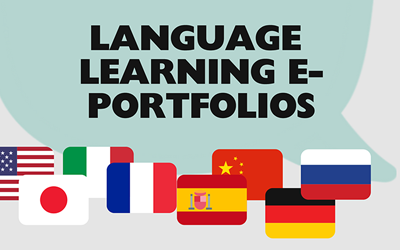
In 2014, colleagues from French and Spanish initiated a project to integrate ePortfolio pedagogy in beginning and intermediate language courses. This project, directed by Emily Scida (Spanish) and Karen James (French), was supported with three years of LTi grants and over time included faculty and courses in seven world languages (Arabic, Chinese, Italian, French, Portuguese, Russian, Spanish) at all undergraduate levels as well as graduate courses. Yitna Firdyiwek (Instructional Designer, A&S Learning Design and Technology) provided valuable mentorship and support throughout the project.
The following faculty played key roles in the implementation of the project in their language programs: Lilian Feitosa (Portuguese), Rachel Geer (French), Esperanza Gorriz (Spanish), Elizabeth Hall (French), Stella Mattioli (Italian), Bilal Maanaki (Arabic), Suad Mohamed (Arabic), Kate Neff (Spanish), Esther Poveda (Spanish), Cécile Rey (French), Pam Rini (Spanish), Spyros Simotas (French), Paula Sprague (Spanish), Matthew Street (Spanish), Ran Zhao (Chinese).
Our project sought a more comprehensive approach to assessment of language learning (including communicative competence and cultural competence) both at the course level and at the program level through ePortfolio integration. In other words, ePortfolios support student assessment in a particular course as well as between courses and at the end of the language sequence (ending with the 2020 level). The ePortfolio model of assessment facilitates a more global and comprehensive evaluation of student performance in all areas of language learning – linguistic knowledge (grammar, vocabulary, pronunciation, etc.), proficiency development (speaking, listening, reading, and writing), and cultural learning – by prompting the student to collect, choose, and reflect on those artifacts from the course that best represent their progress in each of the areas described above. Artifacts selected for the ePortfolio include multimedia projects or assignments, such as video or audio oral exams, video projects, digital storytelling, etc. The portfolio also provides students with a personalized space to reflect on their learning in a particular assignment, on their progress at the end of a course, and upon completing the intermediate world language sequence in 2020. In creating their portfolio, the student sets goals, self-assesses their own learning along the way, and evaluates and refines future goals, resulting in a more self-directed learning experience.
Integration of a learning portfolio in these courses also benefits the teacher. The ePortfolio allows instructors to assess student learning more globally, with a collection of student artifacts of their progress in multiple modes of communication in one place. These artifacts include activities to assess cultural competencies and skill development – listening and speaking through audio or video files, reading and writing through text or other multimedia. The tool also helps new teachers (new GTAs) to develop their pedagogical materials and refine and reflect on their teaching style and goals. Instructors who use this method of assessment might easily apply it to other courses and contexts in their future teaching.
Publications:
James, K., Scida, E., & Firdyiwek, Y. (2019). ePortfolios in a World Language Learning Curriculum. In ePortfolio-as-Curriculum: Diverse Models and Practices. Ed., Kathleen Blake Yancey. Sterling, VA: Stylus.
Scida, E., James, K., & Firdyiwek, Y. (2016). E-portfolios for Assessment of Student Learning in World Language Programs. The Language Educator 11 (2), Mar/Apr.